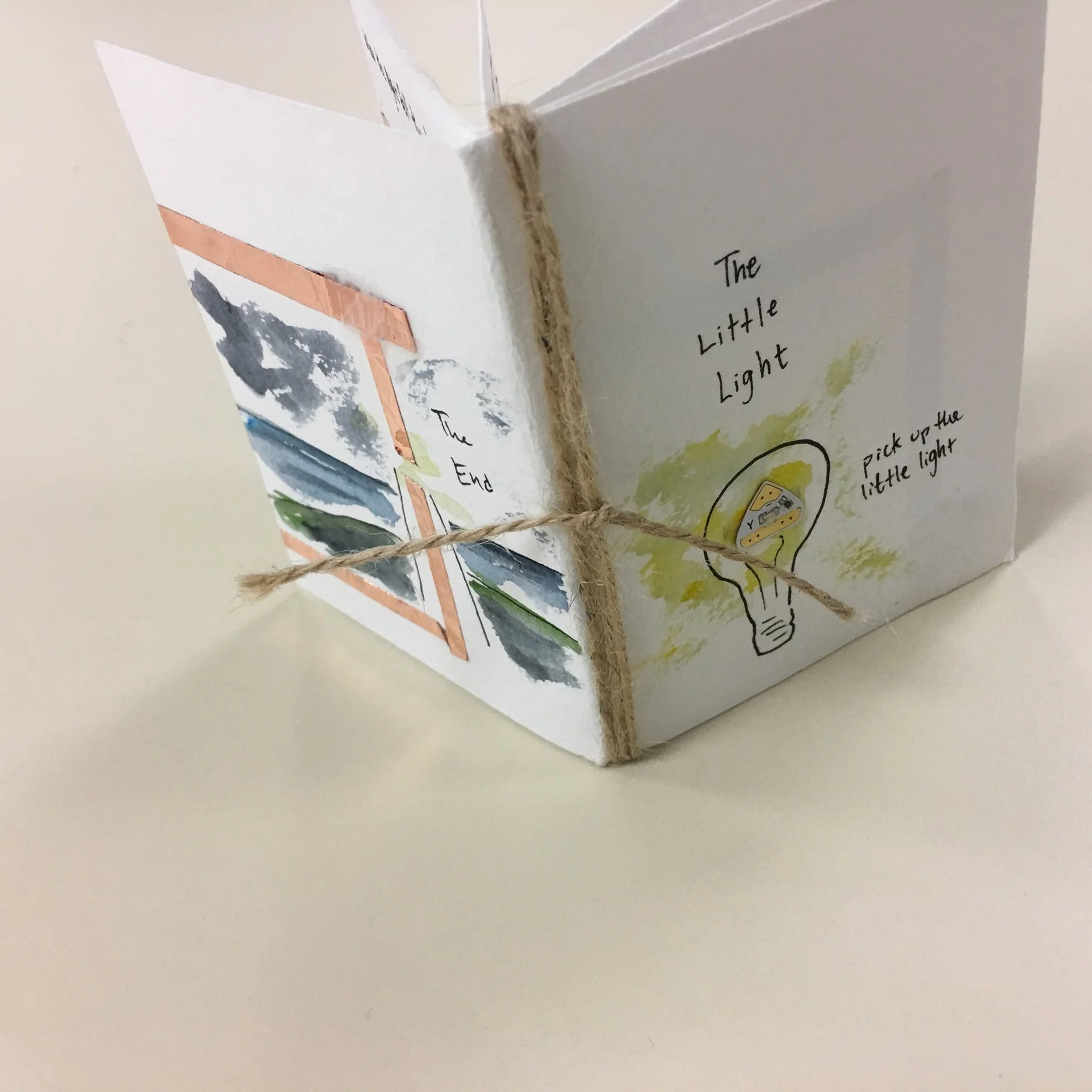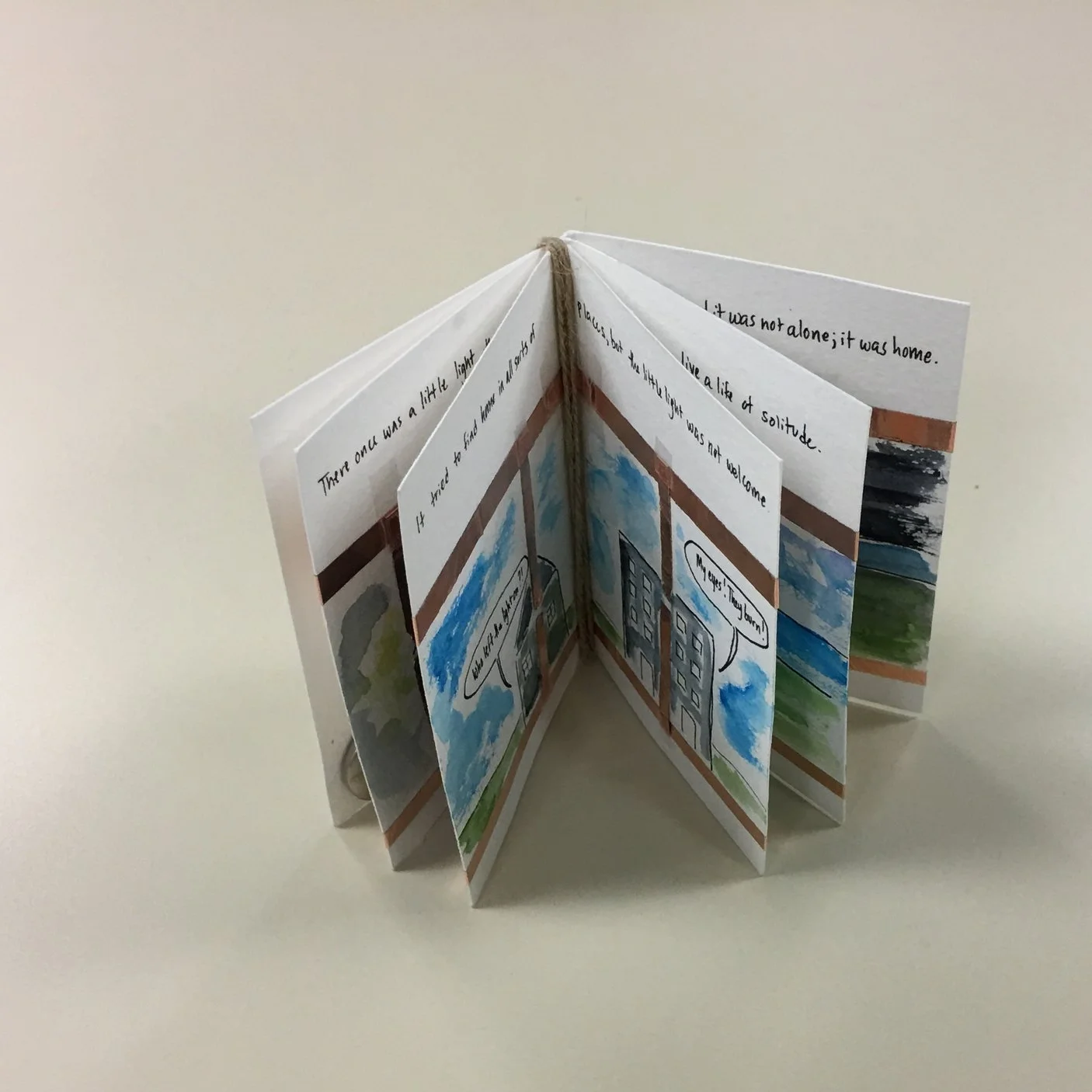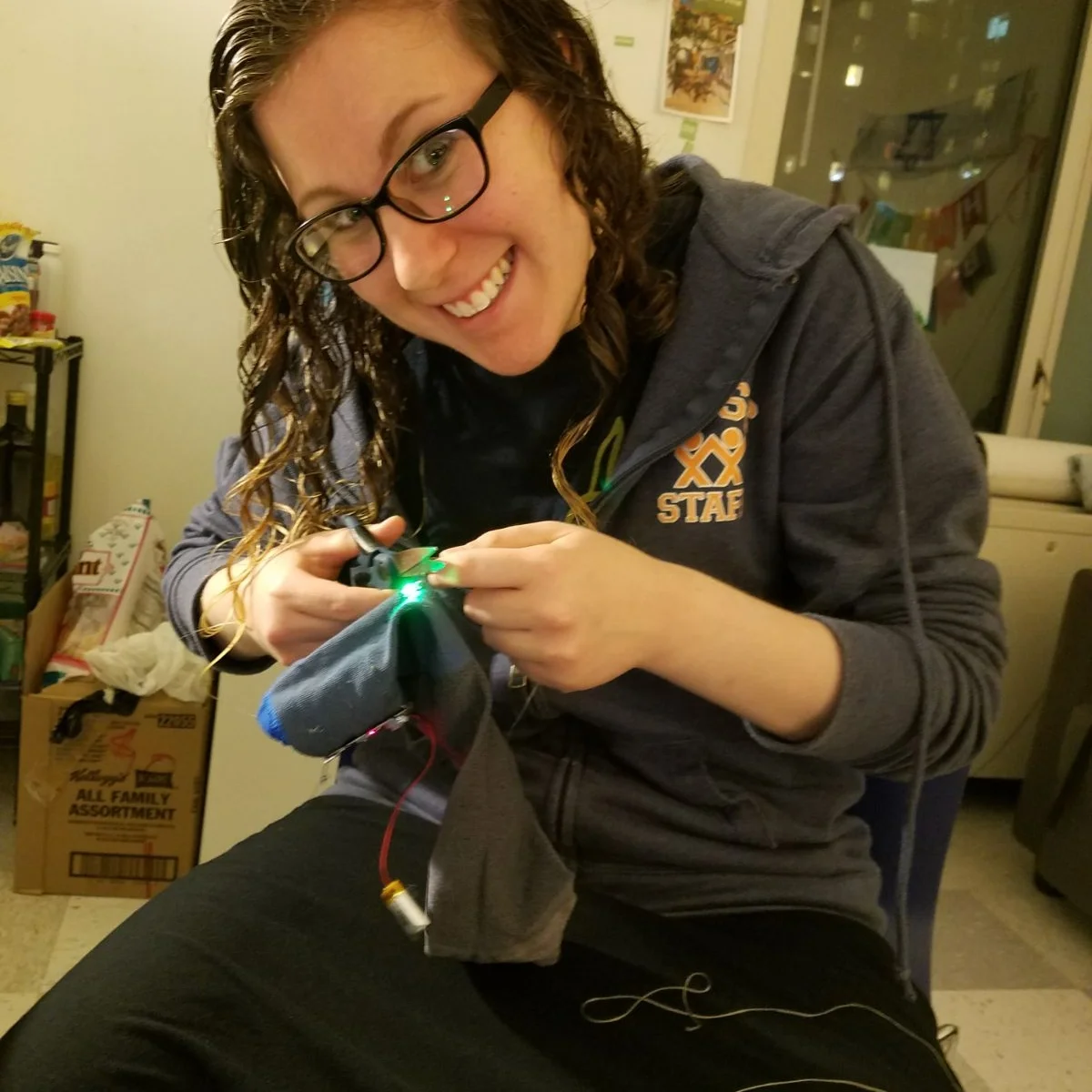Makerspaces for Education
In the Spring of 2017, I completed a course in University of Pennsylvania’s Graduate School of Education called Makerspaces. The class explored theories and practices surrounding educational applications of the maker movement and maker culture. With an emphasis on technology and design, the curriculum combined hands-on experiences of learning through making, as well as critical analysis. Each of the three projects below include two sections: (1) a description that outlines the project’s scope, materials, and design, and (2) reflections on the making process as related to the readings from the course.
Fruit Counter Game
A Makey Makey STEM pack project for Makerpaces in Penn’s Gradate School of Education.
Details
Description: Fruit Counter is a two player game made with conductive material, Makey Makey kits, and Scratch software. Hardware includes two foam boards taped together and covered with paper, playdough-and-penny buttons equivalent to $0.01, $0.05, $0.10, $0.25, and $1.00, aluminum-foil-rectangle buttons, three fruit, a small tub of playdough for the default ground, Makey Makey kits with alligator wires and an Arduino board, and computer. The software for Fruit Counter was developed by Parker Stakoff using Scratch, and can be found at https://scratch.mit.edu/projects/147248935/.
During gameplay, players take the roles of Seller or Buyer. Sellers set a fruit price by tapping fruit with a marked price to add to the total. Once the fruit price is set, Buyers try to match the paid price to the fruit price by tapping piles of pennies. The round is over when the paid price matches the fruit price, at which point a fruit party ensues.
Additional introductory and expert levels were considered during the initial planning stages, but they were not included due to time and resource constraints. The final prototype for this project presents one re-playable round, but perhaps future iterations would incorporate more levels.
Reflections: The Fruit Counter project was my first fully collaborative project experience for the course, and it demonstrated the value of teamwork to me. Parker and I approached the project with our respective strengths and backgrounds, and we accomplished together what we could not have accomplished alone. It reminded me of observations from the Harvard Educational Review comparative case study: “..the project’s scope requires the distributed expertise of multiple members (Sheridan 2014, 516).” Beyond the division of labor around our areas of expertise, Parker and I both benefited from discussing problems together and working toward solutions. As two examples, Parker advocated for large aluminum foil buttons on the physical interface that would be easy for players to reach, and I suggested digital interface layout simplification that would minimize coding. We remained in constant dialogue about our ideas and approaches.
Our formal design process was influenced by the theory we encountered in readings and in class. For example, we referred to Blikstein’s concept of “selective exposure” when securing the wires. Blikstein observes, “depending on their theoretical or pedagogical commitments, designers select aspects of the technology they either want exposed to users or hidden from them” (2013, 173). We wanted to make sure the wire paths wouldn’t create an unnecessary distraction for players, but we also wanted to keep our handiwork visible for those who wanted to take a closer look “under the hood.”
The Fruit Counter project was an excellent example of Jenkins’s “Convergence Culture,” or “the merger of previously distinct cultural forms and practices [that] emphasizes how one can choose among many forms to participate socially in new media cultures” (Peppler 2007, 4). The project included the integration of many disciplines -- such as visual art/design, circuitry, programming -- and it required the convergence of many problem-solving skills. I felt like I learned a lot from this collaborative creative project.
Sources:
Blikstein, Paulo. "Gears of our childhood: constructionist toolkits, robotics, and physical computing, past and future." Proceedings of the 12th international conference on interaction design and children. 2013.
Jenkins, Henry. Confronting the challenges of participatory culture: Media education for the 21st century. The MIT Press, 2009.
Peppler, Kylie A., and Yasmin B. Kafai. "From SuperGoo to Scratch: Exploring creative digital media production in informal learning." Learning, media and technology 32.2 (2007): 149-166.
Sheridan, Kimberly, et al. "Learning in the making: A comparative case study of three makerspaces." Harvard Educational Review 84.4 (2014): 505-531.
The Little Light
A paper circuits project for Makerpaces in Penn’s Gradate School of Education.
Details
Description: My project is an 8 page interactive novel titled, The Little Light. The narrative tells a story of a lonely little light in search of a home. After facing failure, rejection, and contempt, the little light retreats in isolation to an abandoned tower. When night falls however, the little light realizes that it can help guide ships to safety; it is not alone and it has found a home.
As readers make their way through the story, they are invited to place the protagonist (the little light) in various designated locations throughout the book. When properly placed, the little light shines and becomes a key part of the unfolding drama. The technical design that supports this interaction is a large parallel circuit that travels from the beginning to the end of the story, with multiple intermediary branches of the circuit that are completed with the little light. Ink and watercolor illustrations decorate the pages and provide the narrative text.
My making process was guided by two integrated principles: feasibility and scope. Throughout my project, I constantly stepped back from my final prototype to check and plan various aspects of my design.
First, I focused on feasibility. Without considering the aesthetic, I verified that I could set up a circuit across the pages of a book. I then made a small paper prototype to work through the narrative pace of text and illustration. Finally I set to work on my final version, using thick watercolor paper for the pages, and string for the binding. While working on the final version, I often experimented with smaller paper prototypes to solve problems I encountered. Additionally, I sought the advice from friend and classmate Parker Stakoff. With these methods I changed my overall circuit layout from a simple circuit to a parallel circuit, and I added reinforcement-tape along the inner spine of the book.
One particular frustration I found was in evaluating and correcting my roadblocks. It was difficult to determine if my failures were due to conceptual misunderstandings of the material, or simply poor material conditions. For example, one of the instances in which the circuit stopped responding was caused by a tear in the inner spine of the book. I could not initially identify the problem; instead I assumed that my computations were incorrect or the tape was deficient. Once Parker pointed out the the tears however, I was able to patch them up with copper tape as reinforcement. This was not an aesthetically-ideal solution for me, but it restored my project’s functionality. While I would have preferred clearer variables, this process of making still struck me as valuable and comparable to the sort of hands-on engineering-problem-solving that takes place in real life.
Reflections: I noticed that I played by my strengths and approached the assignment with certain biases. I enjoy telling stories and creating pictures, and I knew my final project would be narrative driven from the start. This decision guided my future progress, offering both constraints and context to ground my work. Depending on the context in which teachers introduce paper circuits as a learning tool, they may want to encourage students to create projects using their familiar skill sets to instill a sense of accomplishment, or they may want to encourage students to branch out from their areas of expertise to try new experiences.
In light of last week’s readings (Gauntlet and Rose in particular), I examined the relationship between my thinking and making. The learning scenario Rose describes on pages 109-110 is especially resonant: “You give yourself over to the task; it takes what it takes.” With clear goals in mind and resources to solve problems, I found it very natural to power through the making component of the project -- similar to the way I lose myself in fine arts projects -- which required an interplay between critical thinking and design. My integration of thought and craft still remained somewhat distinct however. I approached functionality and aesthetics as separate aspects of the project, which seems somewhat incongruent with Rose’s observation that “there is often a relation between appearance and function: the graceful bend in a line of conduit looks good but also contributes to a secure assembly (115).” The fusion between form and function that Rose describes is an aspirational goal for me; with more time and resources I imagine the circuitry of my project could be aesthetically refined to more holistically support the project as a whole.
As a final reflection from our reading material, I can identify with feelings of pride for one’s work, and wanting to share my project. I was very excited to show my roommate my book, and I looked forward to presenting my project to the class.
Sources:
Rose, Mike. The mind at work: Valuing the intelligence of the American worker. Penguin, 2005.
E-Socks
An e-textiles project for Makerpaces in Penn’s Gradate School of Education.
Details
Description: As another collaborative project, Parker and I designed pairs of E-Socks. We started with two pairs of patterned socks and added decorative material to them to frame our lights. One pair of socks was colored with different shades of blue. The border between two large portions of color resembled a horizon line, so we added a lighthouse and rocks to the original sock pattern. We integrated our lights to represent a star and a pulsing lighthouse light. This pair of socks is meant to be a transmedia complement to an earlier project, the paper circuit story called The Little Light. The other pair of socks featured a fish pattern. Parker and I added fishermen and fishing line, and we situated our lights to represent bait. Unfortunately the lights for this pair of socks were much weaker, and in our final design the lights are too faint to see through the sock.
Reflections: This project provided many learning opportunities and moments for reflection. Working with Parker again reinforced the value of teamwork and group efforts. We were able to use our strengths to work on complementary parts of the projects. Through our dialogue and coordination, we were able to learn about areas about which we were less familiar, and we offered support and advice to each other to make sure the project would ultimately succeed. While this division of labor has proven to be successful, we also tried to be mindful to not keep our workflows too distinct that we wouldn’t be able to learn new things; it was a positive learning experience, and I’m glad we could collaborate on this project.
Another learning moment occurred when Parker and I switched strategies between the two socks. While designing our lighthouse sock, we turned the sock inside out to keep the wires hidden (Blikstein). This blackboxing technique was effective but time consuming, and it presented challenges in aligning our design with a surface that was not immediately visible. For our fish sock, we decided to keep the wire on the outside of the sock to minimize these types of complications. This method provided serious advantages and expedited the process, but switching our process presented its own challenges in acclimating to the new workflow.
As a final point of reflection, solving an unforeseen and circumstantial roadblock ended up being one of the most gratifying moments of this project for me. During one stage of our making process, we were unable to access necessary materials that were stored in a locked file cabinet. In a class that values out-of-the-box problem solving and the mindsets that are brought to educational opportunities (Dougherty), it felt appropriate to consider my approach to the locked cabinet as part of the project. I systematically studied the challenge and tried various methods to better understand the problem and unlock the cabinet, until finally I succeeded. Once we looked inside, we realized the material we sought was not there, and we had to come up with a different solution to our material problem. Despite this, solving the problem of the locked cabinet felt like a very important part of the project for me.
Sources:
Blikstein, Paulo. "Computationally Enhanced Toolkits for Children: Historical Review and a Framework for Future Design." Found. Trends Hum. Comput. Interact. 9.1 (2015): 1-68.
Blikstein, Paulo. "Gears of our childhood: constructionist toolkits, robotics, and physical computing, past and future." Proceedings of the 12th international conference on interaction design and children. 2013.
Dougherty, Dale. "The maker mindset." Design, make, play: Growing the next generation of STEM innovators (2013): 7-11.
Resnick, Mitchel, Robbie Berg, and Michael Eisenberg. "Beyond black boxes: Bringing transparency and aesthetics back to scientific investigation." The Journal of the Learning Sciences 9.1 (2000): 7-30.
Resnick, Mitchel, and Brian Silverman. "Some reflections on designing construction kits for kids." Proceedings of the 2005 conference on Interaction design and children. 2005.













